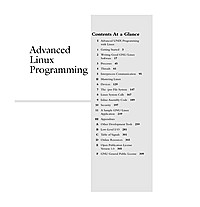
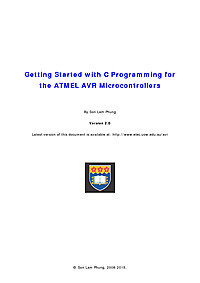
Getting Started with C Programming for the ATMEL AVR Microcontrollers
This tutorial provides information on the tool and the basic steps for programming the Atmel AVR microcontrollers using C. It is aimed at people who are new to this family of microcontrollers. The Atmel STK500 development board and the ATmega16 chip are used in this tutorial; however, it is easy to adopt the information given here for other AVR chips.

PIC Microcontrollers - Programming in C
If you haven’t done it so far then it’s high time to learn what the microcontrollers are and how they operate. Numerous illustrations and practical examples along with detailed description of the PIC16F887 will make you enjoy your work with the PIC microcontrollers
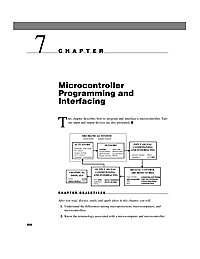
Microcontroller Programming and Interfacing
Chapter 7 of the book: Introduction to Mechatronics and Measurement Systems
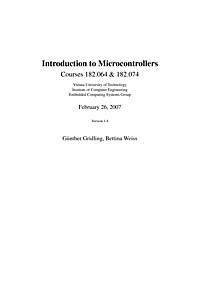
Introduction to Microcontrollers
This text has been developed for the introductory courses on microcontrollers taught by the Institute of Computer Engineering at the Vienna University of Technology. It introduces undergraduate students to the field of microcontrollers – what they are, how they work, how they interface with their I/O components, and what considerations the programmer has to observe in hardware-based and embedded programming. This text is not intended to teach one particular controller architecture in depth, but should rather give an impression of the many possible architectures and solutions one can come across in today’s microcontrollers. We concentrate, however, on small 8-bit controllers and their most basic features, since they already offer enough variety to achieve our goals.
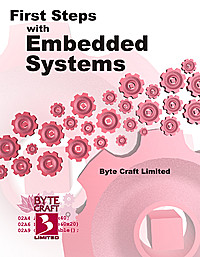
First Steps with Embedded Systems
This book is intended to fill the need for an intermediate level overview of programming microcontrollers using the C programming language. It is aimed specifically at two groups of readers who have different, yet overlapping needs. The first group are familiar with C but require an examination of the general nature of microcontrollers: what they are, how they behave and how best to use the C language to program them. The second group are familiar with microcontrollers but are new to the C programming language and wish to use C for microcontroller development projects. First Steps with Embedded Systems will be useful both as an introduction to microcontroller programming for intermediate level post-secondary programs and as a guide for developers coping with the growth and change of the microcontroller industry.
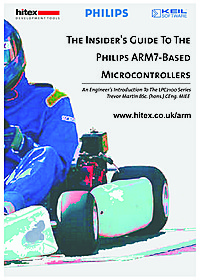
An Engineer's Guide to the LPC2100 Series
This book is intended as a hands-on guide for anyone planning to use the Philips LPC2000 family of microcontrollers in a new design. It is laid out both as a reference book and as a tutorial. It is assumed that you have some experience in programming microcontrollers for embedded systems and are familiar with the C language. The bulk of technical information is spread over the first four chapters, which should be read in order if you are completely new to the LPC2000 and the ARM7 CPU.
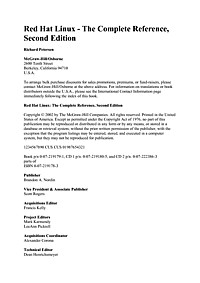
Red Hat Linux - The Complete Reference
This book identifies seven major Linux topics: basic setup, environments and applications, the Internet, servers, administration, and network administration. These topics are integrated into the different ways Red Hat presents its distribution: as a desktop workstation, network workstation, server, and development platform
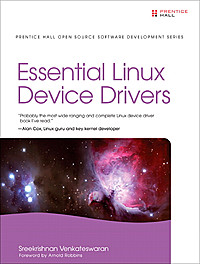
Essential Linux Device Drivers
This book is about writing Linux device drivers. It covers the design and development of major device classes supported by the kernel, including those I missed during my Linux-on-Watch days. The discussion of each driver family starts by looking at the corresponding technology, moves on to develop a practical example, and ends by looking at relevant kernel source files. Before foraying into the world of device drivers, however, this book introduces you to the kernel and discusses the important features of 2.6 Linux, emphasizing those portions that are of special interest to device driver writers.
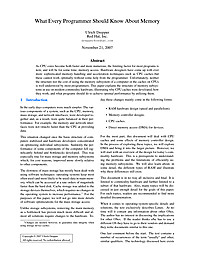
CPU Memory - What Every Programmer Should Know About Memory
As CPU cores become both faster and more numerous, the limiting factor for most programs is now, and will be for some time, memory access. Hardware designers have come up with ever more sophisticated memory handling and acceleration techniques–such as CPU caches–but these cannot work optimally without some help from the programmer. Unfortunately, neither the structure nor the cost of using the memory subsystem of a computer or the caches on CPUs is well understood by most programmers. This paper explains the structure of memory subsystems in use on modern commodity hardware, illustrating why CPU caches were developed, how they work, and what programs should do to achieve optimal performance by utilizing them.
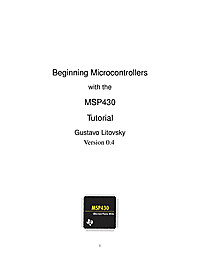
Beginning Microcontrollers with the MSP430 - Tutorial
From the Preface: I decided to write this tutorial after seeing many students struggling with the concepts of programming the MSP430 and being unable to realize their applications and projects. This was not because the MSP430 is hard to program. On the contrary, it adopts many advances in computing that has allowed us to get our application running quicker than ever. However, it is sometimes difficult for students to translate the knowledge they acquired when studying programming for more traditional platforms to embedded systems.
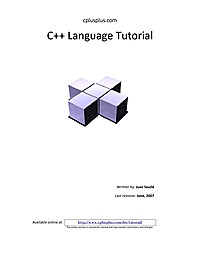
C++ Tutorial
These tutorials explain the C++ language from its basics up to the newest features of ANSI-C++, including basic concepts such as arrays or classes and advanced concepts such as polymorphism or templates. The tutorial is oriented in a practical way, with working example programs in all sections to start practicing each lesson right away

First Steps with Embedded Systems
This book is intended to fill the need for an intermediate level overview of programming microcontrollers using the C programming language. It is aimed specifically at two groups of readers who have different, yet overlapping needs. The first group are familiar with C but require an examination of the general nature of microcontrollers: what they are, how they behave and how best to use the C language to program them. The second group are familiar with microcontrollers but are new to the C programming language and wish to use C for microcontroller development projects. First Steps with Embedded Systems will be useful both as an introduction to microcontroller programming for intermediate level post-secondary programs and as a guide for developers coping with the growth and change of the microcontroller industry.

Microcontroller Programming and Interfacing
Chapter 7 of the book: Introduction to Mechatronics and Measurement Systems

CPU Memory - What Every Programmer Should Know About Memory
As CPU cores become both faster and more numerous, the limiting factor for most programs is now, and will be for some time, memory access. Hardware designers have come up with ever more sophisticated memory handling and acceleration techniques–such as CPU caches–but these cannot work optimally without some help from the programmer. Unfortunately, neither the structure nor the cost of using the memory subsystem of a computer or the caches on CPUs is well understood by most programmers. This paper explains the structure of memory subsystems in use on modern commodity hardware, illustrating why CPU caches were developed, how they work, and what programs should do to achieve optimal performance by utilizing them.

PIC Microcontrollers - Programming in C
If you haven’t done it so far then it’s high time to learn what the microcontrollers are and how they operate. Numerous illustrations and practical examples along with detailed description of the PIC16F887 will make you enjoy your work with the PIC microcontrollers

Introduction to Microcontrollers
This text has been developed for the introductory courses on microcontrollers taught by the Institute of Computer Engineering at the Vienna University of Technology. It introduces undergraduate students to the field of microcontrollers – what they are, how they work, how they interface with their I/O components, and what considerations the programmer has to observe in hardware-based and embedded programming. This text is not intended to teach one particular controller architecture in depth, but should rather give an impression of the many possible architectures and solutions one can come across in today’s microcontrollers. We concentrate, however, on small 8-bit controllers and their most basic features, since they already offer enough variety to achieve our goals.
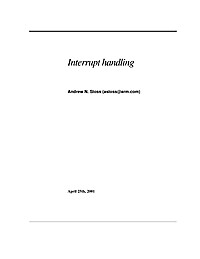
Interrupt handling in an ARM processor
This document is going to guide you at every step as you sit down to design the interrupt handling in software for an ARM system.

An Engineer's Guide to the LPC2100 Series
This book is intended as a hands-on guide for anyone planning to use the Philips LPC2000 family of microcontrollers in a new design. It is laid out both as a reference book and as a tutorial. It is assumed that you have some experience in programming microcontrollers for embedded systems and are familiar with the C language. The bulk of technical information is spread over the first four chapters, which should be read in order if you are completely new to the LPC2000 and the ARM7 CPU.






